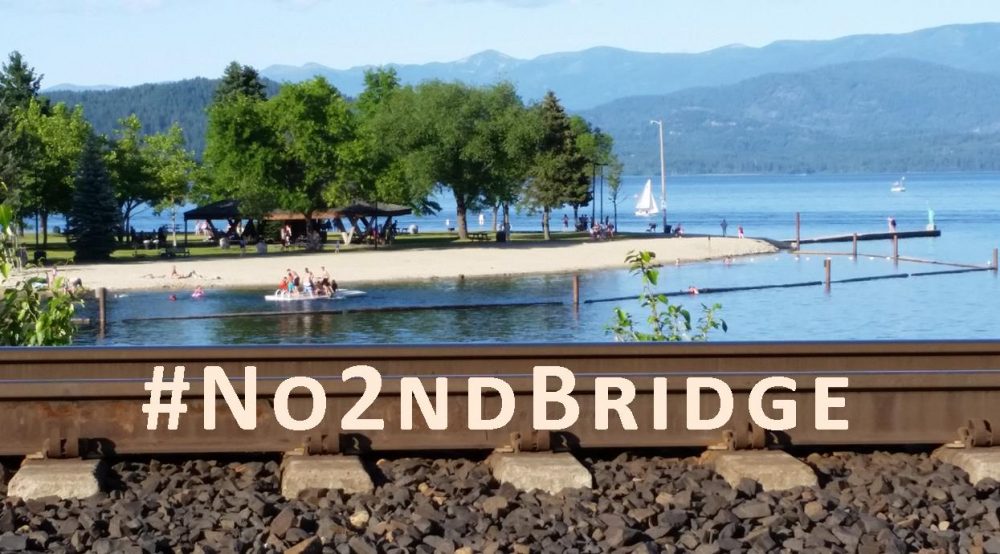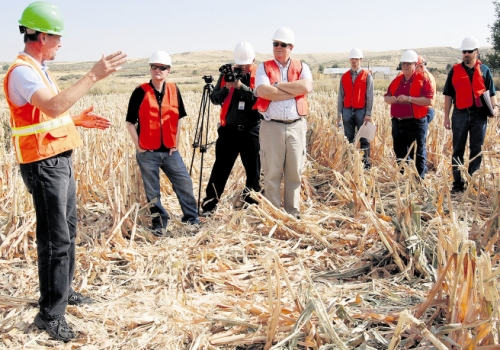On Thursday and Friday, August 1 and 2, Idaho Residents Against Gas Extraction (IRAGE) and Wild Idaho Rising Tide (WIRT) arranged carpools from north Idaho and Boise to the current Payette County drilling area, to stage the first, overdue, public, on-site, oil and natural gas drilling protest in Idaho history. With continent-wide recognition through Earth First! Newswire coverage, even Utah comrades called WIRT and considered participation. At 3 pm MDT on August 2, friends, family, and neighbors gathered with their fracking/drilling protest signs and banners, cameras and binoculars at the A & W Restaurant/Chevron gas station just north of Interstate 84 Exit 3 in southwestern Idaho. These dozen protesters from across the state and country chanted and waved signs at the nearby high-traffic corner of Highways 95 and 30. They then followed organizers to the Smoke Ranch well site on Highway 52, from where Alta Mesa Services had moved a drilling derrick to the new ML Investments well pad, soon after the IRAGE/WIRT announcement of this demonstration of outrage.
Along Highway 52, the protesters observed the capped well head and pad of the first directionally drilled natural gas well in the state, located in a floodplain full of standing water, wetlands, riparian areas, and a wildlife refuge, between the Payette River and Big Willow Creek. The ultimate outcome of the Smoke Ranch well could set a precedent for looming drilling/fracking on and under nearby state lands and waters already leased by Alta Mesa and Snake River Oil and Gas. From the roadside only a few miles upstream from the City of Fruitland municipal water intake and the Payette/Snake River confluence, IRAGE activists had monitored the well site daily. On that sunny August afternoon, the first time that many of the demonstrators had seen Idaho oil and gas facilities, Alma Hasse of IRAGE described the prior activity and equipment at the well site, and pointed out the location of a possible diesel fuel or drilling mud spill clean-up that she and Tina Fisher documented on July 21. Everyone also noticed the close proximity of working ranches and community irrigation canals to the well situated below distantly recognizable sandstone cliffs and bluffs.
At the last stop during this great educational and expressive event, concerned citizens converged along Little Willow Road, to view the derrick and operations of the ML Investments 2-10 well, situated on a private road and property. No news reporters joined the protesters as they considered, discussed, and learned about the strong, impending possibilities of compromised air and surface and ground water quality, threatened environmental and human health, and jeopardized local agricultural, recreational, and economic productivity, which oil and gas exploration and production of the Hamilton/Willow gas field could impose on the surrounding rural landscape. Participants talked about a looming third new well since drilling resumed after a few years in June, as well as a proposed pipeline connecting Payette County gas wells to Idaho Power Company’s Langley Gulch natural gas-fired power generation plant near New Plymouth. As industry and government continue to hide their fracking intentions for the region, which do not require public notice or comments and could spur well treatments soon, several state, county, and city police cruised by or chatted with demonstrators at all three sites visited on that Friday.
Protest at Smoke Ranch Well (July 29 Earth First! Newswire)
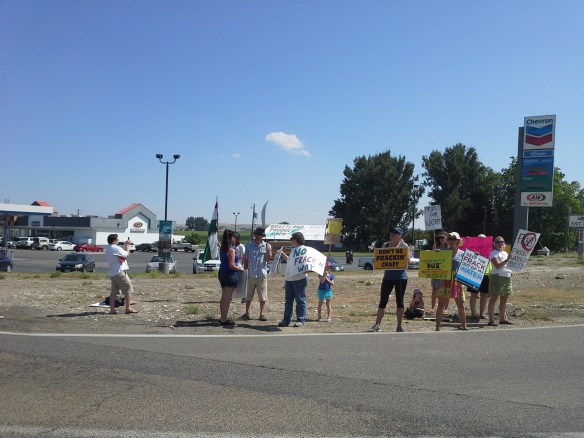
Protesters from across the state and country chant and wave fracking/drilling protest signs at the high-traffic corner of Highways 95 and 30 near Interstate 84 Exit 3 in southwestern Idaho.
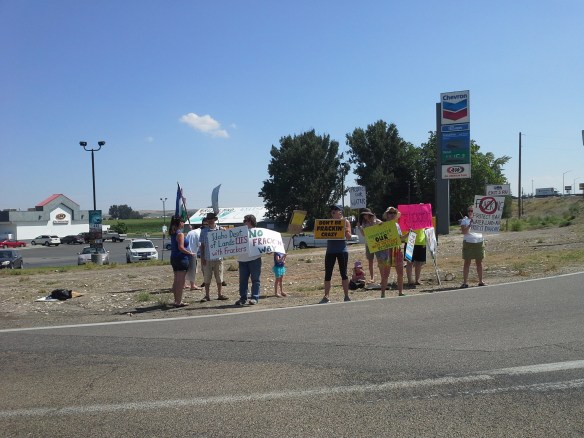
Protesters from across the state and country chant and wave fracking/drilling protest signs at the high-traffic corner of Highways 95 and 30 near Interstate 84 Exit 3 in southwestern Idaho.
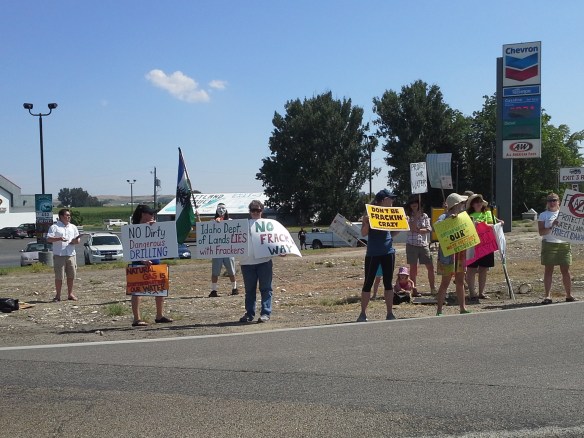
Protesters from across the state and country chant and wave fracking/drilling protest signs at the high-traffic corner of Highways 95 and 30 near Interstate 84 Exit 3 in southwestern Idaho.
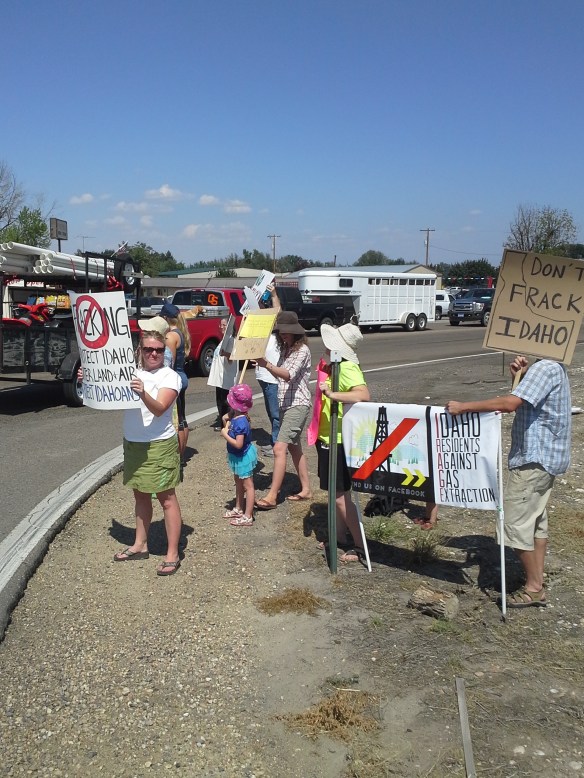
Protesters from across the state and country chant and wave fracking/drilling protest signs at the high-traffic corner of Highways 95 and 30 near Interstate 84 Exit 3 in southwestern Idaho.

Protesters observe the capped well head and pad at the Smoke Ranch site south of Highway 52, the first directionally drilled natural gas well in the state, located in a floodplain full of standing water, wetlands, irrigation canals, riparian areas, and a wildlife refuge, between the Payette River and Big Willow Creek, only a few miles upstream from the City of Fruitland municipal water intake and the Payette/Snake River confluence.
